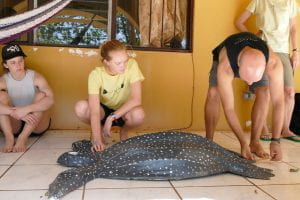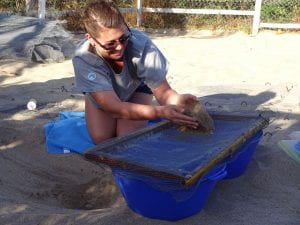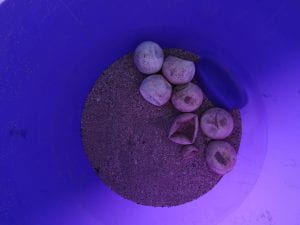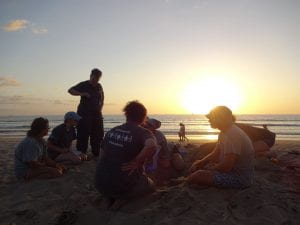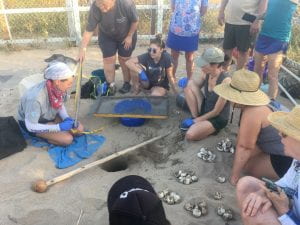This past winter break, I was awarded the opportunity to travel to the Guanacaste Province of Costa Rica to volunteer with the Leatherback Trust (TLT) through the Partnership for Global Conservation Experiences program sponsored by Muriel K. Horacek, Cornell, and Earthwatch. I arrived on the 9th of January and stayed until the 17th, working alongside ten other Earthwatch volunteers and six TLT biologists. TLT is an international non-profit organization dedicated to sound research and community action to monitor sea turtle populations globally. I lived and worked at the Goldring-Gund Biology Station located on Playa Grande and volunteered within Parque Marino Las Baulas. The station is headquarters for research on the critically endangered Eastern Pacific leatherback, a species special in its large size, far habitat range, and deep-diving abilities. It is referred to as a “flagship” species for the other species of sea turtles, all of which are threatened or endangered to some degree. Impacts on turtles come in the form of nest disturbance, development and habitat loss, fishing entanglement and bycatch, light, noise, and plastic pollution, and climate change. TLT aims to address these threats in their goals for protecting sea turtles in its collaborations, partnerships, and conservation efforts. Below is my daily blog, recounting my experiences, thoughts, and feelings throughout the trip. Thank you, Ms. Horacek, Dr. Morreale, TLT, Cornell, and Earthwatch, for making this opportunity a reality.
9 January 2020
Today we arrived at the field station, ready for the beginning of the Earthwatch Team 8 Expedition. The Leatherback Trust has a house split into two parts, one for the field biologists and the other for volunteers. My roommate is Linda, a psychology professor at UMass Amherst. After moving in and choosing a bed, we headed to Kike’s, a local restaurant owned by Kike, a good friend of Frank Paladino, the PI on the project. Most of the team ate the traditional Costa Rican casado, rice and beans served with salad and fries. We all delighted in the homemade hot sauce made by Yani, Kike’s wife, and the bright yellow bottles which were filled not with mustard but with Lizano, a sweet Costa Rican salsa. After returning to the station, we listened to an introductory presentation of the project from Frank. You could feel the anticipation amongst the 10 volunteers, who had all traveled from different places (mostly in New England) to work on the same project.
Earlier that day, some Playa Grande beach-goers recovered several olive ridley turtle hatchlings and brought them to the station. The field biologists put the turtles in a cool, dark spot in the bodega to keep them cool and calm until the evening when the sun would go down and they would be ready to go the ocean. So around 8pm, the team got to see our first hatchling release. Guided by the light from the stars and the moon, the young turtles made their way down to the shore. We watched the little turtles head to the ocean from their starting point farther inshore. We learned the importance of them starting a good distance from the waves in order to gain fin strength and have time to imprint on the beach that someday they will return to.
Naps were taken before the first 6-hour patrol of the trip, which started at 11pm. Teams of three (two volunteers and a field biologist) patrolled the three sections of beach, looking for turtle tracks to signify a nesting turtle or hatchlings coming out. We would walk about 15km each night, checking each part of the beach to make sure we intercepted any turtles during their nesting or hatching process. I was on Playa Ventanas with Cara and Linda. We didn’t see any turtles but had good conversation until the early morning when the shift ended. By 6am, I was in my bed, ready for some sleep!
10 January 2020
In the morning, the team awoke and headed to Kike’s for a group breakfast. All of our meals would occur here, a breakfast around 11am and dinner at 6pm each day. After getting back to the station, there was time to explore on my own before the next activity. I headed to the beach where I had spent the evening, a very different place during the day. The ocean water was so warm and inviting but I didn’t stay for long because an olive ridley nest excavation was happening in the hatchery – something I definitely did not want to miss! We learned about the purpose of these nest excavations and got to see the adorable hatchlings squirming around, ready for their release into the ocean. They and we would have to wait until 8pm though since navigation into the ocean at night is a process facilitated by moonlight and empty beaches.

Hatched eggshells are buried back on the beach to return nutrients back to the environment they came from
Another nap before 11pm helped prepare us for our nightly patrol shifts. This time I was on South Beach with Adam and Denny, though I spent a while hanging out on North Beach, where the famed leatherback turtle, Felicia, came onto the beach to lay! Around 2am she made her way out of the water and laid 66 eggs. Communicating by walkie talkie, we heard the news and Adam took us over to that location in order to see the miraculous process. Felicia was already in her trance when we got there, digging out a hole in the sand with her powerful flippers, alternating between the two sides of her body to create the cavity. We stayed long enough to see the eggs drop from her cloaca; round, white orbs filled with the potential for future leatherbacks and even longer to watch her cover the hole and head back out to the ocean. Being a part of this scene truly felt like a gift – something that few are lucky enough to see in their lifetimes. We were all taken aback by the beauty and mystery of it all. The evening ended with the team continuing their respective patrols on the beach, each person processing what they had seen earlier. Around 5am when the shift was nearing its end, we heard a call on the walkie talkie from Cara. “Hey! Are you guys seeing this?! Look up in the sky!!” We all spun around, staring upwards, trying to orient ourselves to see what she was seeing. When we did, we couldn’t believe our eyes. There, in the southern direction, was a string of star-like objects, moving along an invisible path through the sky. One after another, dozens of these “bioluminescent space whales,” as we deemed them, crossed the sky. A couple quick Google searches confirmed they were SpaceX Starlink communication satellites in orbit, which were first launched into space on May 24, 2019. It was a perfectly bizarre ending to a magical night.

An image found on the web that shows what we saw, as reference. No one is allowed to have phones or cameras on the beach at night, so we couldn’t snap our own photo!
Link to webpage:
https://www.space.com/spacex-starlink-satellites-spotted-night-sky-video.html
11 January 2020
After breakfast at Kike’s, I went with Alison and Cory, two past Cornellians and advisees of Dr. Morreale’s, to South Beach to triangulate a nest’s location for easier recovery. The biologists measure the distance of the nest from two set points in the vegetated berms, usually wooden posts that aren’t expected to move or change location in the near future. These measurements are very important to the biologists in a large expanse of sandy habitat that can easily conceal nesting locations!
After recording the nest’s location, I headed off with the team to Tamarindo, about a 30-minute drive away, to explore and check out some of the local businesses. Tamarindo is a busy, touristy surfer town, made up of restaurants and stores packed into two main roads which cross like a T. It was neat to see the handmade pottery and jewelry made by local artists and to grab an ice cream at the best place in town. After wandering around a bit more, we all piled back into the van to get back to the station for a nest excavation with Anna.
Excavations happen basically every day at 4pm but there is always something new to learn at each one! This time we got to dig out a leatherback nest, where there were seven hatchlings waiting for their turn to head to the ocean. An interesting find during the excavation was an unhatched egg in Stage 2, a picture-perfect example of this period of development. Even the field biologist, Anna, who has worked on several turtle projects and done many excavations, had never seen an egg like this when she opened it.

This is the hatchery where eggs at risk of predation or disturbance are relocated to. When the eggs hatch and the hatchlings make their way out of the nest, they are taken to the ocean to be released.
At 11pm, I headed out for a shift in the hatchery with Janice, where we set up a mosquito net tent in order to evade the pesky insects. We took turns stretching our legs by going out on patrol as well. I went to North Beach and spent a few hours there.
12 January 2020
Today was considerably less busy than previous days. Some turtles did come up in the hatchery in the morning and were extracted for later releasing. But aside from team meals, we had the majority of the day to spend how we wanted. I used that time to roam the beach and play in the ocean. Every day here has been beautiful and sunny and I can’t resist going to the water whenever I can. I journaled and sent some emails and texts but for the most part, relaxed around the field station. With no phone service and limited Wi-Fi, contact with others is not very frequent and pretty quick, mostly just the occasional text to say I’m safe and maybe a picture of a recent nest or group of hatchlings. It’s nice to be in this setting where the most important thing is the work in front of us. The volunteers are needed in order to run the project efficiently and it feels good to be connected to something so important.
At 4pm we had a leatherback nest excavation, which is always exciting and inspirational. We marveled at how strong and big the turtles’ flippers are in comparison to their bodies, and watched them clamber over each other, active and ready to get to the ocean.
In the evening, I patrolled North Beach with Tamara and Diane. The tide got so high when we were patrolling that we were splashed up to our butts with ocean water!
13 January 2020
Today we went on an estuary tour as a group. Enrique was our tour guide and led us around in his blue, covered boat. We saw a crocodile, many birds and howler monkeys, and some crabs and lizards too. A highlight was getting out to check out the tamarind trees and trying some of the fruit that had fallen off the tree. It’s bitter but tasty and we took a few to enjoy on the boat ride back to the dock.

Enrique, a certified howler monkey impressionist (his call is amazingly accurate) with his tour boat.
Today’s nest excavation yielded 14 olive ridley hatchlings, who we sent to the ocean in the evening. At night I patrolled North Beach with Alison and Libby, the three team members closest in age! Alison is a former Horacek Fellow, now working as a field biologist with TLT.
Every night/early morning that we spend on the beach, I get better and better at identifying constellations. You can see the stars so clearly here; the Southern Cross, Big Dipper, Sirius, Cassiopeia, and Gemini, among others, are consistent friends above us. We see them travel across the sky as the evening passes into morning and are even practicing telling time with the relation of the moon to the horizon! On the ground, we found sand dollars buried into the wet sand. You can easily find them by looking for their wide tracks close to the water’s edge. Though I’ve searched for many marine invertebrates, I have never seen live sand dollars, until now!
14 January 2020
I woke up “early” this morning (which meant getting out of bed by 10am) in order to check out the tide pools on Playa Grande at low tide before breakfast. I was so glad that I skipped that extra hour of sleep! I found many sea hares, nudibranchs, and beautiful crabs, all within inches of each other. The best tidal pool had a colony of anemones in it, a beautiful pattern of small green rings.
I was on nest check during the day, which meant I helped run out to the hatchery every 20 minutes to make sure the nests were doing well and recover any hatchlings that came up during that time. No hatchlings did and so the shift ended with no major events, but some of the big activities of the day included science communication workshops led by two experts on the volunteer team, Linda and Carolyn. Interactive and informative, the lessons gave us skills to practice in our future work, as well as opportunities to bond more with our other team members.
Tonight was supposed to be my night off from patrol duty, but there was too much activity for me to sleep! I ended up going out to South Beach with Anna and Denali, where we saw an anteater and a momma olive ridley! She laid 88 eggs and fell asleep during the process (kind of an unusual occurrence) and since she had never been located on this beach before, we got to name her. We called her Sleepy Jean, saw her do the traditional olive ridley dance where she rocks her shell back and forth, thumping the sand on either side of her as she buries the nest she created. Sleepy Jean had no tag and was believed to be a young turtle who had recently reached sexual maturity.
15 January 2020
Adam gave a more in-depth presentation on the Leatherback Trust and its history today. He waited a few days from the start of our expedition to give us time to adjust to the area and formulate our own questions and curiosities of the place. We learned about the incredible physiology of the leatherbacks, the key players in the creation of TLT, and the big factors affecting turtle populations. The group listened intently and posed many questions, and ended the discussion feeling even more motivated to help the project.

Responsibilities and activities for the day would be posted on this board outside of the field station.
Later that day, I had a late patrol shift from 12am to 5am with Cory and Carolyn. We didn’t see any turtles but did run across a couple guys making their across the beach from an evening out on the town. Cory reminded them of the park regulations due to turtle nesting and they went on home. Encounters with people on the beach are not unusual, even though the National Park prohibits people from being there in the night/early morning. The field biologists gain experience in interacting with the public in this way, not as enforcers of the law but as scientists explaining their mission and the importance of following the rules for the safety of the wildlife.
16 January 2020
Today the team took a trip out to Playa Carbon, a nearby black sand beach, to go snorkeling. I had never been to a black sand beach before and it was amazing to see one for the first time! Volcanic rock jut out from the sand, creating cracks and dips for seawater to fill in – perfect little tide pool habitats for some really cool marine invertebrates! We saw many sea hares, as well as some barnacles, anemones, and tiny fish! While snorkeling, we saw an octopus and a sea star, hanging out right beside each other. Though several of us tried to snap a photo, it was difficult because the current and waves kept pushing us under the surface. We also saw a moray eel, dancing around in the water.
Back at the station, we had the last excavation of our trip, where we dug 19 hatchlings out of an olive ridley nest. I helped transport many of the turtles into their temporary bucket home, which was such a neat experience because I got to feel how small and delicate they are.
The evening “started” with an early patrol shift from 7pm to 12am. I started on North Beach and ended on South, splitting my time between the two in order to experience both beaches on the last night.
After that, I went on a walk with Anna to look for nighttime creatures. We crossed the road in the back of the station to look in the vegetation on the other side. We saw and heard some frogs, and came face to face with a sleepy lizard stretched out on a branch. We were lucky enough to snap a quick picture of that moment.
17 January 2020
On the final day of the Earthwatch Expedition, the team ate breakfast together one last time at Kike’s. Our project leader, Adam, asked us to go around the table and share a high and low from the trip. When it got to be my turn, I expressed my sadness that we all only had 8 days together. On the flip side though, I said, it was inspiring to me to see the amount of connection and bonding that can form between people in such a short time when they get together and work hard towards a common cause. The amount of dedication these people outside of the environmental career realm had to protect sea turtles was refreshing and inspiring. I felt like my eyes were opened up to the optimism and kindness that often gets overlooked when confronted with the magnitude of the earth’s environmental issues.
Later that day, finally on a plane back to the States (after a stressful car breakdown situation) I had a window seat with a wonderful view of the North Pacific Ocean. The sun was setting with a red and orange glow, a beautiful ending to a meaningful journey in Costa Rica. The sky was blanketed with white clouds above a blue sea and I was struck by how so many of those fluffy white puffs looked like sea turtles, swimming through an open, unknown expanse.
Reflecting on this trip and experience, knowing what I do about the numbers and statistics, it’s clear that the turtles are severely at risk, especially the critically endangered leatherbacks. Even with that knowledge, I didn’t feel sadness on my way home. I felt a sense of hope. The people I shared this trip with, the ones that come out to volunteer and the ones that dedicate their lives to constantly monitoring these turtles, are doing good, hard work that really means something and makes a difference. There are still turtles, there are many people that care, there are solutions, and therefore there is still hope.
~ Emma Railey
Please visit this page to learn more about what you can do to help the turtles: https://leatherback.org/.
